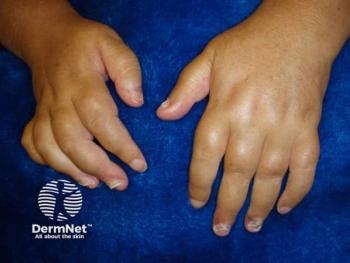
Study Limitations in Generalized Pustular Psoriasis
Aaron S. Farberg, MD, and Jeffrey Crowley, MD, discuss study limitations regarding health records in generalized pustular psoriasis and how the number of flares could be underestimated.
Episodes in this series

Aaron S. Farberg, MD: I have a few more questions. You already touched on this. Studies are great, and this was a very well done study. Are there limitations? What should we be cautious of? Let’s recognize that there are some inherent limitations with a retrospective database study. Are we underestimating? Are we overestimating? Tell me what’s wrong with this study.
Jeffrey Crowley, MD: These studies have a lot of limitations. The first limitation is that you have to have a diagnosis of GPP [generalized pustular psoriasis]. The whole screening is based on having a diagnosis of GPP. Someone has to know that the patient has generalized pustular psoriasis; otherwise, they’re not included in this network. We’re not capturing a lot of the experience that many patients have before getting the diagnosis. That’s probably leading to an underestimation of this disease and disease flares overall. That’s my assessment of it.
Aaron S. Farberg, MD: That hearkens back to when I was learning dermatopathology. The eye can’t see what the mind doesn’t know. If you don’t know what GPP is, then we’re limited in how we can identify and diagnose within our EHR [electronic health record] systems, so there are going to be limitations. That’s why it’s important to do these rigorous studies. I’m happy to see this 1. I’m looking forward to more. Given all the findings that we have, as well as the unmet needs of our patients suffering from GPP, when you’re thinking of new therapeutic advances for these patients, what metrics do you want to see? What should be investigated? What’s important? What are you going to look for in a new therapy?
Jeffrey Crowley, MD: First, decreasing flares, the overall length of flare, and preventing new flares over time. Those are the things I want to see. I don’t think we’re going to see that with the data and approvals we have, but there are more studies ongoing. There are more studies ongoing with the IL-36 receptor antagonist. There are more studies ongoing with other drugs within this space. We’re going to see things play out over the next 5 years or so. I want someone to help me with a drug that I know can treat a flare up front. Then I want to be shown that I can use that drug or another drug over time to help prevent a flare. That’s the holy grail of getting our hands around treating this disease. We’re going to need some more data to answer those 2 questions.
Aaron S. Farberg, MD: Metrics are very important. These data help drive those metrics, particularly for me. As I’ve discussed, the most important thing I’m asking my patient as to whether or not a therapy is working well or not is their pain and their quality of life. Fortunately, this disease also has a very obvious sign, which is the pustules. Are we clearing the pustules? These are some of the important metrics. There’s a laundry list of other symptoms that are also important, but when we think about ourselves as clinicians, we can’t go through every single 1. Those are the types of outcomes I’m looking for. Now that we have an approved treatment, we’re looking at a variety of consensus panels and getting as many experts together to help better define these metrics. We have them in psoriasis, atopic dermatology, and many other fields, but GPP has been lacking until recently.
Transcript edited for clarity
Newsletter
Like what you’re reading? Subscribe to Dermatology Times for weekly updates on therapies, innovations, and real-world practice tips.





















